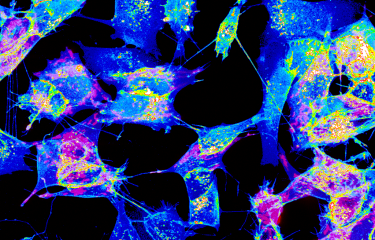The Research’s Journal, for its second year, offers a return on the most read articles in 2018. An exceptional year, marked by the milestone of the 130 year anniversary of the inauguration of the Institut Pasteur (November 14th, 1888) which has been rich in scientific discoveries for the benefit of everyone’s health.
Autoimmune diseases, cholera & big data
Autoimmune diseases: When our own defenses turn against us
Type 1 diabetes, multiple sclerosis, rheumatoid arthritis, ankylosing spondylitis, psoriasis, systemic lupus erythematosus, vitiligo, Crohn's disease and Guillain-Barré syndrome – these seemingly different diseases all have one thing in common: they occur when a deregulation of the immune system causes it to "attack" the organism that it is supposed to be protecting. These "autoimmune" diseases, which currently affect around 5 million people in France, are the third most common category of disease in industrialized countries in terms of morbidity and mortality, after cancer and heart disease. Although there are treatments to slow down the progression of autoimmune diseases, there is currently no cure.

Each factor has a small effect, and the effects of all those factors together give rise to the disease
Cholera: a public health threat that still causes devastating outbreaks
Nearly a million people are currently suffering from cholera in Yemen, a worrying reminder that cholera remains a topical issue and a serious and fatal illness. Often thought of as an ancient disease, cholera is an acute intestinal infection caused by the Vibrio cholerae bacterium. Since the early 19th century, there have been seven cholera pandemics around the globe, resulting in millions of deaths. A few weeks ago scientists proved that the seventh cholera pandemic (which is currently raging in Africa, and has been since 1971) originated in Asia, as did the majority of antibiotic-resistant strains of cholera that are isolated on this continent.

21,000 to 143,000 deaths due to cholera worldwide each year
Cholera vibrio with its flagella implanted on the centrosome. Agent of cholera. Colorized image © Institut Pasteur
How big data is revolutionizing health research
Identifying risk factors for disease, helping diagnose cancer, guiding therapeutic choices and monitoring the efficacy of treatment, facilitating surveillance of pathogens – in a huge number of fields, technological progress is now providing biomedical research with vast reams of information (or "big data") about the diseases under study, representing an extraordinary source of new knowledge and medical progress. But the human mind can no longer deal with these data flows by itself – it needs the help of increasingly complex computer tools to manage all this information. So how exactly does it all work?

The human genome is made up of 23,000 genes, representing a "text" of 3 billion letters
Painkiller, brain, vaccines & Great War
Catherine Rougeot and the discovery of a new painkiller molecule
Catherine Rougeot, an Institut Pasteur guest researcher, was recognized by the Institut Pasteur in 2017 for her work in discovering a non-opioid analgesic, today called STR-324. She was appointed member of the National Academy of Inventors in the US on receiving this award. As the Institut Pasteur is celebrating its 130th anniversary this year – November 14, 2018 – let's look back at the discovery of this molecule, which is entering phase I clinical trials this month.

This discovery should lead to the development of a drug likely to offer patients an alternative pain management option
Catherine RougeotInstitut Pasteur guest researcher
Fani Koukouli: A young researcher's odyssey to the inner depths of the brain
Fani Koukouli's decision to pursue a career researching the workings of the brain and identifying new molecules to tackle diseases such as schizophrenia and Alzheimer's did not happen by chance.

Fanny Koukouli, post-doc in the Integrative Neurobiology of Cholinergic Systems Unit © Valérie Zeitoun / Institut Pasteur
Frédéric Tangy, expert from the Institut Pasteur, talks about vaccines of today and tomorrow
In 2017, vaccinology expert Frédéric Tangy was recognized by the Institut Pasteur for his work on the Measles Platform and was elected as a member of the US National Academy of Inventors. As the Institut Pasteur enters its 130th year – it will be celebrating its 130th anniversary on November 14, 2018 – it seemed like a good opportunity to ask the scientist to tell us a little more about his research field. Read on for our interview with Frédéric Tangy, who also co-authored a recent book about vaccines.

People will only be reassured if they are given clear, factual information that is easy to understand
Frédéric Tangy Head of the Viral Genomics and Vaccination Unit, at the Institut Pasteur.
Institut Pasteur scientists during the Great War
On August 3, 1914, war was declared between France and Germany. It was the most horrific and deadly war in history, during which alas, in Pasteur's own words, the law of blood and death prevailed. However, as Pasteur had foreseen, his work and that of other Institut Pasteur scientists saved the lives of thousands of soldiers.

Emile Brumpt, left, in the trenches during the First World War, 1914-1918. At this time he was medical captain of the ambulances in combat zones, and later he was the head of the health service of the Region of Rennes © Institut Pasteur / Musée Pasteur
Tiger mosquito
Tiger mosquitoes: heightened surveillance in France, from May to November 2018
On Monday April 30, 2018, the French Ministry of Health announced that it was stepping up surveillance of the tiger mosquito, Aedes albopictus, which is now present in 42 French départements – twice as many as two years ago. But just how dangerous is this mosquito, vector of diseases such as dengue, chikungunya or zika?

At the Institut Pasteur, the molecular and cellular bases of the functioning of living organisms are analyzed. Interdisciplinary teams seek to understand how information coded in the genome governs cell function. Our research programs, from molecules to whole organisms, reveal pathological mechanisms.
Escherichia coli & new molecules against infections
Multiscale structure of the Escherichia coli genome
The Escherichia coli bacterium is a major focus of research in biology. But the higher-order organization of its genome had yet to be investigated using techniques such as chromosome conformation capture (3C/Hi-C). In a paper published in the journal Cell, scientists from the Institut Pasteur revealed using this approach the existence of several levels of chromosomal folding linked to known proteins, including condensin and the histon-like HU protein, whose roles in maintaining the structure of this genome were until now unclear.

Natural molecules to stimulate human antimicrobial defenses
New therapeutic strategies are now crucial for combating microbial infections given the recurring threat of antibiotic resistance. A new approach involves using molecules from natural pharmacopoeia, i.e. derived from medicinal plants used in traditional Chinese medicine for instance. The antimicrobial properties of these molecules have recently been studied by Institut Pasteur scientists.

At the Institut Pasteur, we study mechanisms governing interactions between pathogens and their hosts. Interest is focused on the multiplication and evolution of microbes as well as the interface between microbes and their hosts and also on the bacterial communities present in various tissues and ecosystems.
Lyme's disease, killer fungus & Staphylococcus aureus
Lyme disease: a study on the speed of transmission by infected ticks
Lyme borreliosis is a disease caused by bacteria of the genus Borrelia that are transmitted by a bite from a tick of the genus Ixodes. Scientists from the Institut Pasteur used mice to study the transmission of bacteria by ticks infected with various European and North American species of Borrelia. They found evidence of rapid bacterial transmission following a bite, with infection occurring within 24 hours of an adult tick bite and sometimes even sooner for nymph bites. This is a timely reminder of the importance of removing ticks as soon as possible after being bitten to prevent infection.

New insight into body's response to killer fungus
Scientists at the University of Aberdeen, with colleagues from several institutions, including the Institut Pasteur, have made a new discovery that could help in the fight against a fungus that kills around 200,000 people every year and causes lung and allergic diseases in millions of others.

Staphylococcus aureus: a new mechanism involved in virulence and antibiotic resistance
An Institut Pasteur-CNRS research team has characterized a Staphylococcus aureus gene involved in virulence, biofilm formation and resistance to certain antibiotics. These results open up new avenues for understanding the control of S. aureus virulence mechanisms. This work was recently published in the journal PLoS Pathogens.

At the Institut Pasteur, we analyze the variability of disease susceptibility and immune responses of populations and decompose the causes and consequences. We model biological systems and host responses to disease processes. We can predict the appearance of diseases, anticipate their treatment, and establish the foundations of a fine medicine.
Immune system, empathy against pain & whooping cough
The factors that most affect our immune system
Why do we respond differently to infections or vaccines? Why are some people allergic to pollen? These are still unanswered questions in biological and medical science. The Milieu Intérieur Laboratory of Excellence coordinated at the Institut Pasteur by CNRS research director, Dr. Lluis Quintana-Murci, has recently described immune variation on a large scale within the French population. To achieve this, the consortium studied an expansive collection of biological specimens from 1,000 French volunteers aged 20 to 69. This article provides an account of their work.

Just the two of us: Holding hands can ease pain, sync brainwaves
Reach for the hand of a loved one in pain and not only will your breathing and heart rate synchronize with theirs, your brain wave patterns will couple up too, according to a new study. The study, by researchers with CU Boulder and University of Haifa, in collaboration with the Institut Pasteur published in the journal Proceedings of the National Academy of Sciences (PNAS) this week, also found that the more empathy a comforting partner feels for a partner in pain, the more their brainwaves fall into sync. And the more those brain waves sync, the more the pain goes away.

Interpersonal touch may blur the borders between self and other
Decades-long trends, rather than flawed vaccine, best explain resurgent whooping cough
A recent study released by the University of Michigan, with first author Matthieu Domenech de Cellès of the Institut Pasteur, shows that the resurgence in whooping cough can be explained not by recent changes in biology or epidemiology, but by several longterm factors, including natural population turnover, incomplete vaccination coverage, and slowly waning protection from a highly effective yet imperfect vaccine.
Read our disease sheet on wooping cough.











